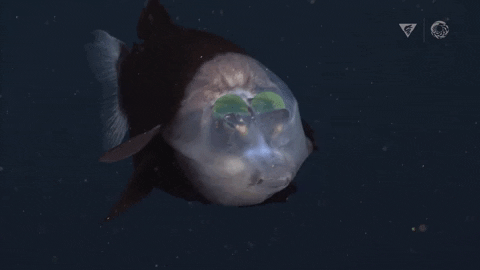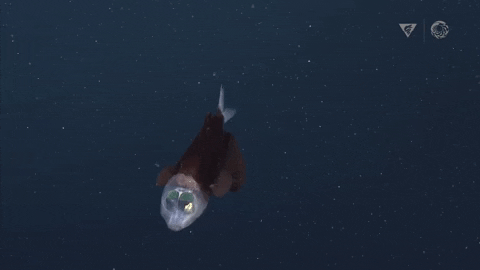New footage shows bizarre deep-sea fish that sees through its forehead
Barreleye fish live in the ocean twilight zone.

Thousands of feet beneath the surface of Monterey Bay off California, scientists recently captured footage of a fish with a bulbous, translucent head and green orb-like eyes that peer out through its forehead.
This bizarre creature, known as a barreleye fish (Macropinna microstoma), is very rarely seen. Researchers with the Monterey Bay Aquarium Research Institute (MBARI) have only spotted the species nine times, despite having sent their remotely operated vehicles (ROV) on more than 5,600 dives in the fish's habitat, MBARI tweeted on Dec. 9.
But last week, a team of scientists deployed MBARI's ROV Ventana and caught sight of a barreleye fish suspended in the water.
Related: In photos: Spooky deep-sea creatures
At the time, the ROV was cruising at a depth of about 2,132 feet (650 meters) in the Monterey Submarine Canyon, one of the deepest submarine canyons on the Pacific coast, Thomas Knowles, a senior aquarist at the Monterey Bay Aquarium, told Live Science in an email. "The barreleye first appeared very small out in the blue distance, but I immediately knew what I was looking at. It couldn’t be mistaken for anything else," he said.
As a buzz of excitement rippled through the control room, Knowles kept the ROV camera in focus while the ROV pilot Knute Brekke kept the underwater robot pointed at the barreleye. "We all knew that this was likely a once in a lifetime experience," since the elusive creature is seen so very rarely, Knowles said.
In the light of the ROV, the barreleye's eyes glowed bright green and could be easily seen through the clear, fluid-filled shield that covers the fish's head. These eyes are incredibly light-sensitive and can be oriented straight up, towards the top of the fish's head, or straight ahead, according to MBARI. Two dark-colored capsules sit in front of the fish's eyes and contain the organs the animal uses to smell.
Sign up for the Live Science daily newsletter now
Get the world’s most fascinating discoveries delivered straight to your inbox.
The barreleye fish's habitat ranges from the Bering Sea to Japan and Baja California. The fish live in the ocean twilight zone, which lies about 650 to 3,300 feet (200 to 1,000 m) underwater; specifically, barreleyes live about 2,000 to 2,600 feet (600 to 800 m) beneath the ocean surface, near the depth where the water plunges into complete darkness, according to MBARI.

Scientists have little sense how many of these gelatinous helmet-heads float in the ocean's depths.
"We have no handle on population size, except in a relative sense," Bruce Robison, an MBARI senior scientist, told Live Science in an email. Barreleyes are less abundant than commonly-seen twilight zone fish, such as lanternfish or bristlemouths, and the MBARI team encounters barreleye fish about as often as they do anglerfish, whalefish and gulpers, "which is very rarely," he said.
Based on past observations by MBARI researchers, published in 2008 in the journal Copeia, scientists think that barreleye fish mostly remain motionless as they wait for unwary prey, like zooplankton and jellyfish, to drift overhead. The fish can hover this way thanks to a set of broad, flat fins that extend out from its body. By pointing their verdant eyes straight upward, barreleyes can spot the silhouettes of their prey from above, and the green pigment in their eyes likely helps filter out sunlight from the ocean surface.
Once a barreleye fish spots a bioluminescent jelly or tiny crustacean floating by, it zooms upward to snag the creature in its mouth while rotating its eyes forward, so it can see where it's going. Scientists speculate that M. microstoma may sometimes swipe food from siphonophores — jellyfish-like organisms that cling together in long lines and capture prey in their tentacles, according to a 2009 MBARI video. The barreleye fish's transparent head shield might protect it against the stinging cells in the siphonophores' tentacles — but again, this is speculation.
"Most aspects of their natural history remain unknown and much of what we think we know about them is based on speculation," Robison said. Although M. microstoma was first described in 1939, fishers caught these early specimens in nets that destroyed their transparent head shields. So scientists didn't know about the shields until the 2000s, when MBARI scientists saw a barreleye fish in its natural habitat, he said. As of today, there's still much to learn about the funky fish.
On their recent dive, the team avidly watched the M. microstoma specimen until it swam away and then continued their search for jellies and comb jellies of the deep sea. "We had no ambition to collect this animal," as the aquarium is not adequately set up to care for the poorly understood fish, Knowles said. That said, many other bizarre and wondrous creatures from the deep sea will soon be on display at the aquarium.
In spring 2022, the Monterey Bay Aquarium will open a new exhibition called "Into the Deep: Exploring Our Undiscovered Ocean," which will feature all sorts of deep-sea creatures, from giant isopods to sea spiders to blood-belly comb jellies, according to the aquarium's website. And like the barreleye fish, many of these creatures look like something plucked straight from a sci-fi novel.
Originally published on Live Science.

Nicoletta Lanese is the health channel editor at Live Science and was previously a news editor and staff writer at the site. She holds a graduate certificate in science communication from UC Santa Cruz and degrees in neuroscience and dance from the University of Florida. Her work has appeared in The Scientist, Science News, the Mercury News, Mongabay and Stanford Medicine Magazine, among other outlets. Based in NYC, she also remains heavily involved in dance and performs in local choreographers' work.










